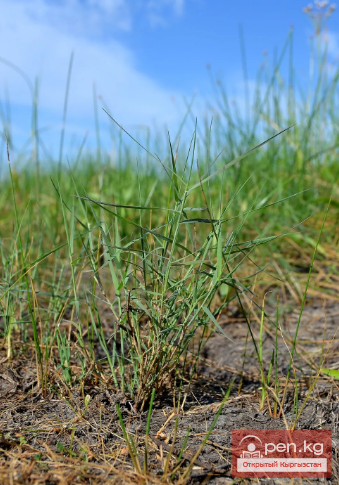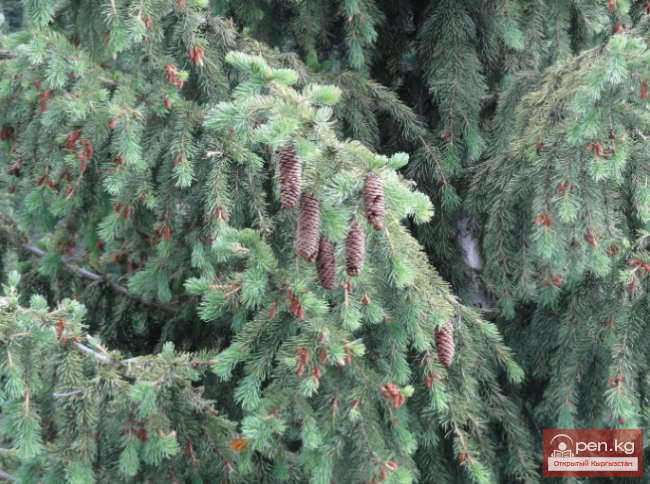
TANNING PLANTS
Despite the current rapid development of chemistry and the creation of many synthetic substances that replace plant-derived materials, the tanning substances of plants still hold immense significance. This is true not only in the tanning-extractive industry but also in medicine and veterinary science.
The demand for tannins in the USSR is high. With more detailed studies of tanning plants, their role does not diminish; on the contrary, it increases.
According to preliminary data from the Republican Scientific Research Institute of Radiology and Oncology of the Kazakh SSR, preparations derived from tanning plants inhibit the growth of cancer tumors: from Tianshan sorrel — by 69%, from horse sorrel — by 64%, and from tarragon — by 78%.
Preparations from tanning plants, especially tarragon, have a positive effect in treating the gastrointestinal tract of animals. Scientists have established that tanning substances play an important physiological role in the biological oxidation-reduction processes occurring in plants. However, the significance of plant-derived tanning substances is not limited to these facts.
Dyeing substances have been found in the roots of tanning plants, which can be used for tinting varnishes and films.
It has also been established that catechins extracted from tanning plants act like preparations made from tea leaves. They increase the resistance of capillary walls, enhance the absorption of ascorbic acid by the body, and positively affect the treatment of hypertension.
Thus, the important role of plant-derived tanning substances in both the national economy and medicine is evident. However, despite this, tanning plants in Kyrgyzstan still receive insufficient attention. Long-term studies of the flora and vegetation of the republic have shown that a significant number of tannin-bearing plants grow in Kyrgyzstan. For instance, while Europe has 40 species of such plants and India has 68, the relatively small territory of Kyrgyzstan has over 86 species of tanning plants.
Tanning plants in Kyrgyzstan grow both in the wild (in deserts, meadows, and forests) and in cultivation.
The most important tanning plants in Kyrgyzstan include: walnut, Schrenk's spruce, pistachio, tarragon, lady's mantle, motherwort, and sea lavender. These plants are abundant in Kyrgyzstan and form a significant reserve of tanning raw materials.
Walnut. Kyrgyzstan is home to the best walnut forests in the world. They are located in the southern part of Kyrgyzstan — in the Chatkal, Fergana, and other mountain ranges. Tanning substances in walnuts are found in the green part of the pericarp.
Schrenk's Spruce is of great economic value. Like the walnut, it also forms forests. Spruce forests in Kyrgyzstan are found on northern slopes at altitudes of 1500—3000 m above sea level. The bark of spruce contains about 11% tanning substances. It has been established that the poorer the forest growth conditions, the more tanning substances are found in the bark of spruce. Since spruce forests in Kyrgyzstan, especially in Central Tien Shan, are in less favorable growth conditions, it is evident that the bark of spruce in Central Tien Shan contains more tanning substances than the bark of trees in other areas.

Pistachio. Tanning substances are found in its leaves (especially in galls) — from 8 to 15%.

Junipers. They create a significant reserve of tanning substances. The leaves and unripe fruits of junipers contain from 6 to 8% tanning substances. However, junipers in Kyrgyzstan have been studied very little in this regard.
In artificial plantations in Kyrgyzstan, oak, sumac, smoke tree, birch, willow, cotton, and other plants containing tanning substances grow.
Overall, Kyrgyzstan has many plants containing tannins, although they are still used very little in the leather industry and medicine.
Research has shown that tannins are present not only in higher plants but also in lower plants.
In Kyrgyzstan, studies on lower plants for tannin content have not been conducted. However, lower tannin-bearing plants from Kazakhstan are also found in Kyrgyzstan. It is believed that lower plants from Kazakhstan also contain tannins under the conditions of Kyrgyzstan, as the ecological conditions of Kazakhstan, where lower tannin-bearing plants inhabit, are similar to those in Kyrgyzstan.
Among green algae in Kyrgyzstan, Cladophora is common. This filamentous alga contains tannins. Cladophora is widely distributed in the water bodies of Kyrgyzstan — ponds, channels.

Among fungi, the dry milk cap, or white undercap, is often found. It grows in the forests of Kungoy Ala-Too, in Kemiye. Its fruiting bodies contain 0.48% tanning substances.
Among lichens in Kyrgyzstan, Parmelia is frequently encountered. Its thalli contain up to 0.49% tanning substances. Parmelia is widespread in wormwood deserts, wormwood-fescue, and wormwood-timothy steppes, especially in Central Tien Shan, the basin of Lake Issyk-Kul, and in the Chui Valley.
In the eastern part of Central Tien Shan, in the Kuilu and Sary-Jaz ranges, beard lichen Usnea often develops on the trunk of Schrenk's spruce. It contains up to 0.49% tanning substances.
Mosses also contain tannins. For example, moss Retidiadelphus contains 0.49% tanning substances. This moss is found in the spruce forests of Kyrgyzstan — almost everywhere. The moss Dicranum has a crown and contains 0.49% tanning substances. This moss grows on moist rocks in the spruce forest zone of Kyrgyzstan.
The fern-like plants also contain tannins. This includes male shield fern, which contains from 1.5 to 2% tannins, common bracken, and common horsetail, which grow in spruce and juniper forests, mainly in the Issyk-Kul basin.
Among the horsetails, field horsetail is tannin-bearing. In Kyrgyzstan, it is found almost everywhere — in places where groundwater is close to the surface, often growing in meadows, gardens, and fields.
Representatives of the Ephedra family also contain tanning substances. For instance, Ephedra distachya contains 6.98—7.88% tannins in its one-year-old branches, 3.64—6.76% in its two-year-old branches, and 1.14% in its perennial branches on an absolute dry weight basis.

Ephedra distachya is widely distributed in Kyrgyzstan. It is harvested by the Pharmacy Management for obtaining ephedrine. However, using this type of ephedra for obtaining tanning substances is impractical, especially since it is also a phytomeliorative plant that protects mountain slopes from erosion.
Other species of ephedra also contain tanning substances.
As for angiosperms or flowering plants, this type of tannin-bearing plants contains the largest amount, especially in the class of dicotyledons. Among monocotyledons, there are very few tannin-bearing plants.

From the family Typhaceae, the presence of tanning substances is noted for Typha laxmannii. Its leaves contain up to 10%. Typha laxmannii grows in Kyrgyzstan on swamps, forming reed swamps, but they are quite small in area.

From the family Poaceae, only Puccinellia distans contains tanning substances.
As already noted, the class of dicotyledons is characterized by the largest number of tannin-bearing species, especially representatives of the families Polygonaceae and Rosaceae. In particular, the family Polygonaceae is the richest in promising tannin-bearing plants.
Let’s characterize some of them.

Common buckwheat, or tarragon. A perennial tall plant up to 170 cm high with a panicle of white flowers. The leaves are large, ovate-lanceolate, with brown lobes. It blooms in June and bears fruit in August.
It grows in tall grass meadows, in forest clearings, sometimes in sparse forests, among shrubs. This is a mesophytic plant. However, it is also found in sparse juniper forests in the meadow-steppes. The most typical thickets of tarragon are located in the western part of Inner Tien Shan, in the Chatkal and Fergana ranges, and in Alai.
In some places, tarragon forms so-called tarragon meadows, where it dominates in the herbaceous layer.
Tarragon is considered the best tanning agent, so it has been harvested since ancient times, especially in the eastern part of the mountainous Fergana. As a result of systematic harvesting of tarragon roots, without considering its regeneration, the natural thickets of the plant have significantly decreased.
Tarragon is used not only as a tanning agent but also in folk medicine. Its decoctions are used to treat bloody diarrhea. Currently, tarragon has been introduced into cultivation. According to N. V. Pavlov, the rhizome of tarragon contains from 15 to 25% tannins; there have been cases where the percentage of tannins rose to 35. The fluctuations in tannins depend on the place of growth, the time of harvesting the plant, and the method of drying the roots. N. V. Pavlov indicates that young tarragon rhizomes are richer in tannins than older ones, and this difference is 5—7%.
In Kyrgyzstan, the possible annual collection of rhizomes and roots is 5—7 thousand tons, which translates to 100—150 tons of pure tanning agents. In cultivation, tarragon reproduces well by rhizomes. Seed regeneration is poor.

Alpine buckwheat, or alpine tarragon. It is also called mountain sorrel. Unlike the previous species, it is shorter. The stems reach 90 cm in height. The leaves are lanceolate, wedge-shaped at the base. The inflorescence is a panicle up to 30 cm long, bearing white flowers. It blooms in June — July and bears fruit in August. It grows in the forest-meadow zone.
It rises higher than common buckwheat. Sometimes it enters subalpine meadows. It is found in Inner Tien Shan, in the basin of Lake Issyk-Kul, in the Kyrgyz range, Talas, in Chatkal, and Alai. This species of tarragon is widely used by the population to treat gastrointestinal diseases, throat and oral cavity inflammation, and even as compresses for wounds. It is also used to treat foot-and-mouth disease in cattle. The stems of alpine tarragon (especially during the flowering period) have a sour taste and can be consumed, which is why it is called mountain sorrel. However, it does not form large thickets. In terms of tannin content, it is similar to common buckwheat.
Dzungarian buckwheat, or Dzungarian tarragon. A perennial rhizomatous plant up to 30 cm high. The leaves are thin, ovate, up to 2—4 cm long. The flowers are red with a whitish-green edge, gathered in a sparse panicle up to 40 cm long.
It grows in meadows, in forests, among shrubs in almost all regions of Kyrgyzstan. It does not rise above the forest-meadow zone. It contains tannins in its rhizomes.
Rhubarb Vitrocca, or sorrel. A perennial tall plant reaching 100 cm in height, with large heart-shaped leaves. The flowers are white, slightly creamy in a sprawling panicle. It blooms in May — June and bears fruit in July.
It grows in tall grass meadows, in forest clearings, in sparse forests, and among shrubs in the forest-meadow zone.
Rhubarb is widely distributed in the Kyrgyz range, in Talas, Chatkal, Fergana, in the basin of Lake Issyk-Kul, and in Inner Tien Shan.
Since ancient times, the stems of rhubarb have been consumed and used as a filling for candies. They have a pleasant sour taste. However, the main value of this plant is the tannins, which are found not only in the roots but also in the seeds, with the seeds containing more tanning substances than the roots. The tannin content in rhubarb roots can be up to 10%.

Maximovich's rhubarb. In folk medicine, this rhubarb is also called sorrel. Maximovich's rhubarb is a perennial plant with a thick root and rhizome; the rhizome has remnants of old leaf sheaths.
The stem can reach up to 100 cm in height. The leaves are kidney-shaped, large — up to 60 cm wide. The flowers are greenish, gathered in a pyramidal panicle. It blooms in May — June and bears fruit in September.
It grows in the forest-meadow zone, in tall grass meadows, in sparse forests and shrubs. It is characteristic of Fergana, Chatkal, and Alai. It contains tanning substances in both the roots and seeds. It is used as a tanning, dyeing, and food plant. The roots contain 14—25% tannins and can be quite large — weighing up to 50—60 kg.

Large-fruited rhubarb. It has a limited distribution. It is found only in Fergana, in its eastern part and in the Atainok range. It grows on clay slopes.
The leaves are very large, kidney-shaped, up to 80 cm wide and 40 cm long. The inflorescence is widely branched. The flowers are greenish with a reddish tint along the edges of the petals. It blooms in May and bears fruit in June. The fruits are very large, up to 3 cm long, orange-pink. The roots contain tannins and are used for tanning and dyeing.
Heart-shaped rhubarb. Unlike the previous one, it is characteristic of Northern Kyrgyzstan. It grows in the Kyrgyz range, in the Chuyli mountains and Kungoy Ala-Tuu on clay-gravel slopes. It is a perennial plant. The roots are 10—15 cm in diameter. The leaves are large, up to 50 cm wide and up to 30 cm long. The flowers are yellowish or pinkish. It blooms in May and bears fruit in June.
Like other species of rhubarb, it contains tannins. Young stems and petioles have a pleasant sour taste and are consumed. It was previously widely used as a tanning agent, dye, and medicinal remedy (laxative), which is why natural thickets have significantly decreased.
Currently, it is subject to protection. The roots contain from 15 to 25% tannins. In Kazakhstan and Uzbekistan, up to 5—6 tons were harvested annually.

Tianshan sorrel. A tall plant. The stems reach up to 2.5 m in height and branch from the base. The leaves are broadly ovate, wavy along the edges, up to 25 cm long and 15 cm wide. The flowers are in whorls, the inflorescence is a panicle.
It blooms in May and bears fruit in June. One plant produces 1800 seeds. The fruits quickly fall off. It grows in river valleys on reeds, starting from 1000 to 1400 m above sea level, in tall grass meadows. It often forms pure patches, especially in cattle pastures. It is characteristic of the Greater and Lesser Kemin, Kyrgyz Ala-Tuu.
In natural conditions, it reproduces by seeds and rhizomes. It contains 25% tanning substances.
In conclusion of this section, it should be noted that the exploitation of tanning plants should be carried out with great caution, considering the processes of regeneration of tanning plants and measures for their protection.
























































